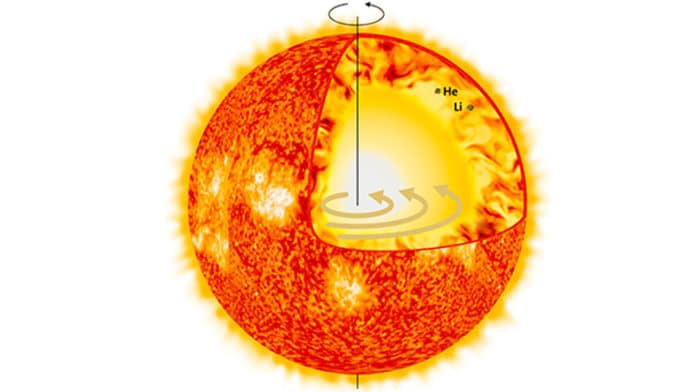The Sun is a great starting point for modeling the many physical processes in stellar interiors. However, the results of helioseismology, which provide information on the nature of the Sun’s interior, are at odds with heavy element abundances. Furthermore, the internal rotation of the Sun and the amount of lithium on its surface have always been difficult to explain.
A team of astronomers at UNIGE, in collaboration with the Université de Liège, has devised a new solar model that solves the part of the ‘solar problem.’ The model, which considers the Sun’s rotation, which varies through time, and the magnetic fields it generates, could explain the chemical structure of the Sun.
Patrick Eggenberger, a researcher at the Department of astronomy of the UNIGE and the first author of the study, said, “We must consider simultaneously the effects of rotation and magnetic fields on the transport of chemical elements in our stellar models. It is important for the Sun as for stellar physics in general. It directly impacts the chemical evolution of the Universe, given that the chemical elements that are crucial for life on Earth are cooked in the core of the stars.”
Along with predicting the concentration of helium on Sun’s surface, the model also reflects that of lithium which resisted modeling until now. It correctly reproduced the abundance of helium because the internal rotation of the Sun imposed by the magnetic fields generates a turbulent mixing which prevents this element from falling too quickly towards the center of the star. It also reproduced the lithium abundance on the solar surface because this same mixing transports it to the hot regions where it is destroyed.
Sébastien Salmon, researcher at the UNIGE and co-author of the paper, said, “However, the new model doesn’t solve every challenge raised by helioseismology: Thanks to helioseismology, we know within 500 km in which region the convective movements of matter begin, 199,500 km below the surface of the Sun. However, the theoretical models of the Sun predict a depth offset of 10,000 km! If the problem still exists with the new model, it opens a new door of understanding: Thanks to the new model, we shed light on the physical processes that can help resolve this critical difference.”
Gaël Buldgen, detailing the next steps said, “We will have to revise the masses, radii, and ages obtained for the solar-type stars that we have studied so far. Indeed, in most cases, solar physics is transposed to case studies close to the Sun. Therefore, if the models for analyzing the Sun are modified, this update must also be performed for other stars similar to ours.”
Patrick Eggenberger specifies: “This is particularly important if we want to better characterize the host stars of planets, for example, within the framework of the PLATO mission. This observatory of 24 telescopes should fly to the Lagrange point 2 (1.5 million kilometers from Earth, opposite the Sun) in 2026 to discover and characterize small planets and refine the characteristics of their host star.”
Journal Reference:
- Eggenberger, P., Bulgin, G., Salmon, S. et al. The internal rotation of the Sun and its link to the solar Li and He surface abundances. Nat Astron (2022). DOI: 10.1038/s41550-022-01677-0
